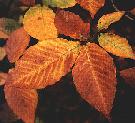
 Beech
|
For a less scientific explanation, please see Fall Foliage Facts. The largest factor in why leaves change color in the
autumn is photoperiodism-the length of day and night. As the nights get
longer in Autumn, the process of senescence becomes apparent through
color change and the falling of leaves, leading the tree into it's winter
dormancy. Photoperiodism Photoperiodism is the mechanism by which many of our
hardwood trees regulate their various life processes, including preparing for
winter. Many plants have the ability to adjust their cycles to the changes in
the amount of available daylight. The day length in North Carolina at the summer solstice,
the longest day of the year, is approximately 14 hours and 20 minutes. By the
autumn equinox on Sept. 22, the length of day and night will be approximately
equal to each other, or about 12 hours each. At the winter solstice, the day
length is about 9 hours and 45 minutes. At the onset of color change, towards
the end of September, the day length is decreasing at a rate of about 2 minutes
per day. Not all species, or even individuals within a species,
respond in exactly the same way to photoperiodism. For instance, there is no
particular day when all of the Dogwood trees say "OK, we've only got 12
hours and 10 minutes of daylight. Time to change color." While species
within an area will generally begin each particular stage of their life at
approximately the same time, there is some degree of differentiation between
individuals, possibly due to the amount of light and shade they get at their
particular location, health of the individuals, or even the amount of cloud
cover during a season. Species too, are more variable with some changing early
and some later. And, not all trees respond to photoperiodism at all - some
respond more to temperature or rainfall. In the forests of eastern North
America though, of the trees that change color in the autumn, most are
responding to photoperiodism. Senescence The processes induced by photoperiodism are called
"senescence", which is a term for the collective process that lead to
the aging and death of a plant or plant part, like a leaf. Senescence is a part
of the larger process by which a plant goes into dormancy. There is more
involved than the gradual reduction of growth. Most notable in the process is the destruction of the chlorophyll which has been responsible for the green color of the leaves throughout the spring and summer and plant growth. As the photoperiod decreases, the plants ability to synthesize chlorophyll becomes reduced, and yellow and orange carotinoids and xanthophylls, always present within the leaf, begin to show. Water and nutrients are being drawn into the stems and away from the leaves. Additionally, senescing cells also produce other chemicals, particularly anthocyanins, responsible for red and purple colors. Some species, particularly the Oaks, contain high quantities of tannins in the leaves which are responsible for brown colors. Dormancy Dormancy is a period in a plant's life of decreased
metabolism. In the deciduous hardwoods of the temperate regions, this period is
usually referred to by the nontechnical term "winter". In preparation
for winter and to prevent or minimize damage from cold, plant cells switch from
production of chlorophyll for growth, to production of sugars and amino acids,
which act as antifreeze for the plant. As already mentioned, chemicals in the
leaves are drawn into the stems and eventually to the roots during this
process. Why Leaves Fall The process by which nutrients from the leaves are
changed into other forms and drawn into the stems and roots is very efficient,
and by it's end, the only remnants in the leaves will be cell walls and
nutrient depleted protoplasm. At the base of the leaf petiole, where the leaf
is attached to the stem, two types of cells are formed. Parenchyma cells, which
are very soft, are formed on the leaf side, Suberized cells which are waxy and
impermeable are formed on the tree side to act as a protective seal.
Eventually, the vascular bundles, the veins of the leaf, are all that hold the
leaf to the tree. The vascular bundles break, or are torn by the wind, and the
leaf falls, leaving what is called a bundle scar, and a bud for next years
growth. |
 |
 |
 |
 |
© 1999 NCNatural
Last updated
For information about advertising or webservices, email "[email protected]"